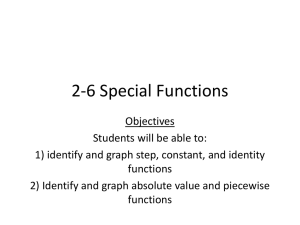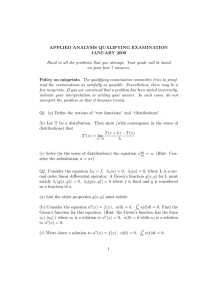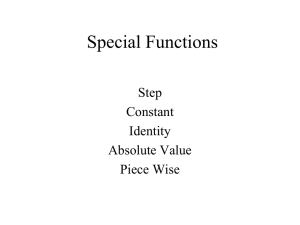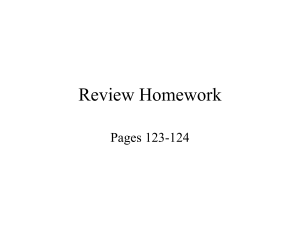Document 10440337
advertisement
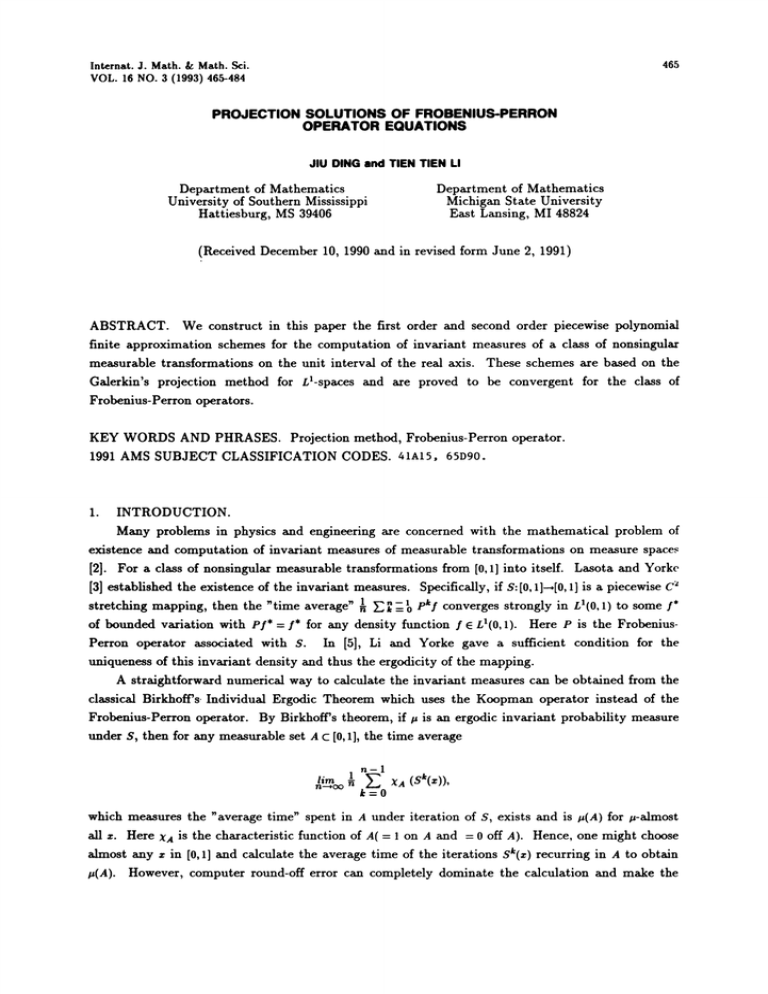
Internat. J. Math. & Math. Sci.
VOL. 16 NO. 3 (1993) 465-484
465
PROJECTION SOLUTIONS OF FROBENIUS-PERRON
OPERATOR EQUATIONS
JIU OING and TIEN TIEN LI
Department of Mathematics
Michigan State University
East Lansing, MI 48824
Department of Mathematics
University of Southern Mississippi
Hattiesburg, MS 39406
(Received December 10, 1990 and in revised form June 2, 1991)
ABSTRACT. We construct in this paper the first order and second order piecewise polynomial
finite approximation schemes for the computation of invariant measures of a class of nonsingular
measurable transformations on the unit interval of the real axis. These schemes are based on the
Galerkin’s projection method for L-spaces and are proved to be convergent for the class of
Frobenius-Perron operators.
KEY WORDS AND PHRASES. Projection method, Frobenius-Perron operator.
1991 AMS SUBJECT CLASSIFICATION CODES. 41A15, 65D90.
1.
INTRODUCTION.
Many problems in physics and engineering
-
are concerned with the mathematical
problem of
existence and computation of invariant measures of measurable transformations on measure spaces
[2]. For a class of nonsingular measurable transformations from [0,11 into itself. Lasota and Yorkc
[3] established the existence of the invariant measures. Specifically, if $: [0,11-[0,1] is a piecewise C
converges strongly in LI(0,1) to some I*
stretching mapping, then the "time average"
of bounded variation with P’*= for any density function f LI(0,1). Here P is the FrobeniusPerron operator associated with S. In [5], Li and Yorke gave a sufficient condition for the
’*
P!
uniqueness of this invariant density and thus the ergodicity of the mapping.
A straightforward numerical way to calculate the invariant measures can be obtained from the
classical Birkhoff’s. Individual Ergodic Theorem which uses the Koopman operator instead of the
Frobenius-Perron operator. By Birkhoff’s theorem, if is an ergodic invariant probability measure
under $, then for any measurable set A [0,1], the time average
n-
n-oolirn
E
XA
(S(z)),
k=0
which measures the "average time" spent in A under iteration of S, exists and is #(A) for /-almost
all z. Here XA is the characteristic function of A(
on A and
0 off A). Hence, one might choose
almost any z in [0,1] and calculate the average time of the iterations S(z) recurring in A to obtain
(A). However, computer round-off error can completely dominate the calculation and make the
466
J. DING AND T.T. LI
implementation difficult. A typical example is given in [4]; and for the purpose of overcoming this
difficulty, Li proposed in [4] a rigorous numerical procedure which can be implemented on a
computer with negligible round-off error problem. The piecewise constant approximation is used to
reduce the original infinite-dimensional fixed point problem to the fixed point problems of
stochastic matrices, thus solving a conjecture of Ulam’s [8].
The numerical procedure proposed by Li has two features. The first one is that it actually
belongs to the category of Galerkin’s projection method, although originally it was obtained by the
probability analysis. The second one is that it uses a sequence of finite rank Markov operators to
approximate the Frobenius-Perron operator. Since Frobenius-Perron operators are also Markov
operators, this kind of approach is natural from the viewpoint of both theory and practice. In this
paper, we propose the first order and second order piecewise polynomial approximation schemes for
the computation of fixed points of Frobenius-Perron operators, based on the Galerkin’s projection
method. The numerical experiments of Kohda and Murao [1] based on a general piecewise
polynomial Galerkin approximation scheme show that the first order and second order piecewise
polynomial approximation methods are much more efficient than the piecewise constant
approximation in [4]. But in order to prove the convergence of their methods, the boundedness as
well as the uniqueness of the invariant density are assumed which makes the convergence analysis
much easier. In [1] the convergence theorem is stated and its proof is based on the variation
analysis of best piecewise polynomial approximations to functions of bounded variation under the
L2-norm along with the fact that every orthogonal projection in a Hilbert space has the operator
norm 1. Without the assumption of boundedness of invariant densities, we show in this paper with
different approach that our scheme is convergent in L 1, which is not a Hilbert space, for the class of
nonsingular measurable transformations satisfying the condition of the Lasota-Yorke theorem. The
method of finite Markov approximations will be developed in further studies.
The paper is organized as follows. In Section 2, we outline some background material.
Sections 3 and 4 are devoted to the first order and second order piecewise polynomial project.ion
approximation methods and their convergence analysis, respectively.
2. FROBENIUS-PERRON OPERATORS AND PROJECTION METHOD.
Let I =[0,1] and S be a transformation from I into itself. For A C[0,1], we write S-I(A! for
{z:$(z) E A}. The Lebesgue measure on [0,1] will be denoted by m. Denote by LI(0,1) the spat,, of
all integrable functions defined on [0,1] with respect to the Lebesgue measure m. L(0,1) is a Banach
spze with norm I
f[f(z)[dz. Let S: [0,1]-,[0,1] be a nonsingular measurable transformation,
i.e., for any measurable subset A of [0,1] with re(A) 0, we have m(S-I(A))=0.
The operators Ps: L( 0,1)-,L(0,1) defined by
is called the Frobenius-Perron operator associated with $. If there is no ambiguity, we shall write P
for Ps" By Ron-Nikodym Theorem, the Frobenius-Perron operator is well defined when S is
nonsingular [2]. For l E L(0,1), the measure t(A)_= tf(A) J’a f(z)dz is invariant under $ if and
only if Psi I- Here the invariance of measure t (under S) means t(5’-l(A))= t(A) for every
measurable set A. Thus, to calculate the invariant measure for S, we may calculate instead the
fixed point of the Frobenius-Perron operator. More precisely, we need f LI(0,1) which satisfies
Psf f"
SOLUTIONS OF FROBENIUS-PERRON OPERATOR EQUATIONS
We list some basic properties of Frobenius-Perron operator
Ps
without proof.
467
For
more
detailed discussion of P s, see [2].
(1) Ps is a Markov operator, i.e., Ps is linear and maps (positive) density functions to
1.
(positive) density functions. Thus Ps
(2) For the n-th iterate Sn, Ps, (Ps)""
We give here a brief description of Galerkin’s projection method in Banach spaces (see [6] for
more details). Let X be a Banach space. Suppose M and Iv are both closed subspaces of X. If
X M + lV and M f3N {0}, then we say X is a direct sum of M and IV and M and IV are
complementary to each other. In this case, we may define a linear operator Q: x-x as follows,
Qz
u
if r
u+v,u
M, vq N.
This operator is continuous and satisfies 0 O. We call 0 the projection of X onto M along IV.
Now, let X and Y be two Banach spaces, T:X.--,Y be a bounded linear operator from X to Y,
and y Y. We want to solve the operator equation
Tz=y
The general idea of projection method is as follows. Choose two sequences of finite-dimensional
subspaces X,, and Y,, of x and Y, respectively. Let {0,,} be a sequence of projections from Y to Y,,.
In x,, we want to find z (") such that Q,(Tz (") )= 0, or
OaTx(n) QnY.
If we choose a basis of X. and a basis of Y,, then the above approximate operator equation of finite
rank can be written as a system of algebraic equations. Thus we can use the usual numerical
methods to solve the linear equation and obtain the approximate solutions to the original problem.
This numerical procedure is referred to as the projection method. In particular, if X Y and if we
choose x,, Y,, and the same basis in Y,, as in x,, then the corresponding projection method is
called the Galerkin’s method.
3. PIECEWISE LINEAR PROJECTION APPROXIMATION OF FROBENIUS-PERRON
OPERATOR.
A transformation
,
will be called piecewise C if there exists a partition
0 ao < a <
of the unit interval such that for each integer k
<a
r, the restriction
of $ on the open interval (%_ 1,%) is a C-function which can be extended to the closed interval
[%_ 1,at] as a C-function. S need not be continuous at the point a.
Assume ,q: [0,1]-,[0,1] satisfies the condition of Lasota-Yorke theorem. That is, ,q is piecewise C
satisfying inllS’(x) > 1. In this section, we look for the approximate solutions of Frobenius-Perron
operator equation Psi ! in the space of piecewise linear functions.
Divide I =[0,1] into n subintervals 11, I I,,. For i=
n, let I =[::i_l,zd and
Denote by A,, the 2n-dimensional subspace of LI(0,1) spanned by the basis {li, zli}=l, i.e.,
A,, L(0,1) is the set of all functions which are linear on each subinterval li.
Define Q,,: LI(0,1)--,A,, by requiring that for
n,
$: [0,1][0,1]
< f- Qnl, 1, >
0
< I Q,,I, zl, >
0.
and
J. DING AND T.T LI
468
L(0,1)= [L1(0,1)] *, < g,h > f g(z)h(z)dz. The following lemma shows
that these requirements uniquely defines Q. and implies that Q. is a projection from L1(0,1) to A.
along +/- A. {g L1(0,1): < g,h > 0 for all h A.}. Because of the similarity in the "orthogonality
condition" with the L2-space case, we may call .:Li(0,1)A. the orthogonal projection, even
though its norm may not be 1.
n. For any l L](0,1), we have
LEMMA 3.1. Let =(x,_ +,)/2,i=
Here for
LI(0,1) and
g
h
,
E (c, + d,z)l,
Q-f
i=1
where for
n,
.=
PROOF. Let Q.I
< Q.f,
>
c
12
m(li)2 fl,
(x
(1)
i(c, + d,z) li, then
> + d, < zli,
< li,
< Qn.f, zli >
12i f (z- ii)f(z)dz
f l, f(z)dz- re(l,)2
ci < li,
’
/1 ci + re(l,)d*
rot.i)
>
zli > + di < zli,
", +
zl >
d,.
mT.r,+
From the condition of the orthogonal projection,
we
have
(2)
The equation (2) has
a
unique solution
ci
12,
fl+ (zII+12f(x)dX-m(li)2
di= ,,,or) Iq(’- ’)I(:)d:-
(Q.E.D.)
The next lemma establishes the uniform boundedness of the sequence Q,.
LEMMA 3.2. For all., Q. < 2.
PROOF. Given n and/" L(0,1),
Q.!
(Q,,.f)(x) dx
o i=1
/ +q m---(+)Ic,’l"d,’zl
I(,:, +
d’"
i=I
By (1),
the value of f on I i. Hence it is enough to
ci+d,zld:r. Without loss of generality, assume di # 0. For simplicity, let
% d d and f be defined on I. Let p(z) (c + dz)/m(1).
on the subinterval
estimate one of
I I [a,b],
:i,
m-))’zl
c
I,, Qaf only depends
on
469
SOLUTIONS OF FROBENIUS-PERRON OPERATOR EQUATIONS
First of all, let us assume l _> 0. If so _> 0, then from the first equality of
f, I (z)ld =/, so(z)dz 1 /
I
(c / dz)
2d
(c + dz)dz
db)
2din(l) [(c +
d2m(1) 2]
2din(l) [2cdm(l) +
-
(2),
(c + da) 2]
c+d
/I f(z)dz-- /i ,f(z) ldz.
:
If so 0, then from .the fact that so is the best approximation to I among all linear functions on [a,b]
under LLnorm if l E L(0,1), we see that so cannot be non-positive. Therefore so must have a zero
z
in (a,b). We assume so(b) > 0 and so(a) < 0. The other case can be treated similarly. Thus we
have
Iso(z)
ldz=1/2[(z-a)lso(a)l +(b-z)lso(b)l]
[(b + )so(b) + (a + )so(a)],
b+
a+
so(b)
1
(c + db)
m(l)2fl f(z)dz + m(I)
12fi (z- )f(z)dz 2
m(1)2l .f(x)dx m(1)
121 ( )I(x)dx 2
1 /
f(z)dz +
6 /
so(b)
Hence,
I
f(z)dz re(l)
Iso(z)Idz--1/2 1( 12./.m(I)2fl
1 (z Y.)f(z)dz/
.re(i)(1 /
f(z)dz +
6/
I
(z )f(z)dz)
m(I):f f(z)dz m(1)
+ 12fl (z- )f(z)dz-T
(1
re(l)
-
/ f(z)dz-6 /
m(l)[]l f(z)dz]
+
12Ii (z Ye)f(z)dz
m(I)[f I f(z)dz]
12fl (z- )/(z)dz
3
/
I
(z )/(z)dz)}
(z- )f(z)dz
+’ /I f(z)dz.
(z )f(z)dz],
470
Note that
It follows that
-
J. DING AND T.T. L
E (a,b), we have
a
<
-
m(l)2fl f(z)dz < b.
12fl (z- .)f(z)dz
m(1)2f f(z)dz
1211 (z- .)f(z)d;r. <
re(l)
--a
T"
Therefore
For general ! E LI(1), write f =f+-f- where f+ =maz{f,0} and f--maz{-f,O}, and
we
have
/I /(z)ldz =/ IQfldz---/z IQf+-Qf-ldz
<_ /. IQf+ ldz+ /z IQf- ldz
<2/ f+d+Z f f-dz=2 f Ifldz
where Q:(l)Span(1,} he ve mentioned orthogoM projection.
From the ave estimate, we obtn
QnI
/’ I(Qnf)(z)l
o
z,
i.e., for
dz
i=1
If(z)ldz=2
I,
m---(,)
ci + dir. dr.
If(z)ld=211fll,
(Q.E.D.)
LEMMA 3.3. en mesh (A) maz{m(li):l
}--O,QII for I LI(0,1)
PROOF. Given /Ll(0,1) d >0, there ests a continuous fction
f- < e. Now
n,
Q,
2.
Q-
n/
]
(Q.g)(y)-g(y)ldy
i=1
En / llim___i) (ci+diY)_g(y)[dy
i=1
12i
rn(ii)3
/ I, (z
g
such that
SOLUTIONS OF FROBENIUS-PERRON OPERATOR EQUATIONS
471
i=1
/ ,i,(t,P( /
12
+
=1
is uniformly continuous on [0,1], when mesh (A.) is sufficiently small, for any
Applying H61der’s inequality, we get
z,y 6. Ivi
n, we have Ig(z)-a(p)l <
Since
.
+
12
I, (z_i)Zdz
re(l,)3
/
[/li 9(z)Zdz] "/I, IP-ildP
11
[/li9(z)2dz]
For n sufficiently large,
1/2
(It, 9(z)dz) 1/ < -3 ,i
n,
hence,
Together with Lemma 3.2, for n sufficiently large,
II QJ- f
_< Oaf- Qng + Qn9- g +
_<211f-gll
II 9- l II
++ II/-gll
This proves limn_..ooOnf f.
(Q.E.D.)
The following result is the key to our convergence analysis.
LEMMA 3.4. For any f G LI(0, I) of bounded variation and for all
n
vQnf < 13 f,
0
i
0
where v f is the variation of f on [0,1] (for the definition of variation, see [7]).
J. DING AND T.T. LI
472
PROOF. By definition, Q.f ,n=t(c,+diz)l o where {c,,d,} are given by
piecewise linear, its variation is given by
vQn f0
[(ci+d,z,)-(ci+d,z, 1)1
i=
n-I c, + d,z,
n
n--I
i=1
i=1
n
n-1
i=1
i=1
c, + + d, + lZi
di.+.l_
,
/ I, f(z)dZ_m(l + 1"- - / li
+1
d(.rn_O
c, +1
c
m(I+1) q+ (z
i + )f(z)dz
12z,
12zi
+m(Ii)a / li (z_i)f(z)dz
n
n--1
i=1
i=1
+
+
m(Ii+l)3
n
n--1
i=1
i=1
m(li+)3
/
(z-
/ li+ (z-
+ t)f(z)dz
1.
/ z,+x f(z)dz
/ q f(z)dz- ,-(+)
12(. + 1.- zi)
m(li)3
12.
m(li)3
f(z)dz
/ Ii+1 (z
i + 1)f(z)dz
/ Ii
f
, / I,+
(z- i + l)f()dz
m(li + 1)2
From the definition of d
/
+ /I
f(z)dz
(z- i)f(z)dz
we have
Idol +
vQ.f_<
0
f(z)dz
](z)dz
m(Zi+a)
/ z+l
f(z)dz
m(li + 1)
/ li +
i=1
i=1
n-1
n-1
n
_<
Id, +
i=1
.)’
=1
+ .]’ Id, I.
(1). Since Q.f
is
SOLUTIONS OF FROBENIUS-PERRON OPERATOR EQUATIONS
473
It is easy to see that the middle summation of the above inequality is not greater than v 0l (for
proof, see [4]). Hence,
Id.I
VQnf _<2
0
4-
=1
a
1Vf.
0
Now we estimate ,"_ [d, [. Let F,(z) f.,_ lf(t)dt, then the formula of integration by parts
for the Stieljes-Lebesgue integral [6] gives
m(li)2
12[
,()
(- ,)F()
I,
.,_
’ -/ , F,(z)d(z
,,)]
where l’t, {(z,t):zi_ _< z _< r i, r,_, _< < z} is a triangular region in the (:,t)-plane and A,
is the area of ni. With the same reason described in [4], we obtain
rl
I’1
i=1
i=1
1/2re(l,)
Therefore,
V Q,f
0
1
< 13 9 f.
(Q.E.D.
0
Let
Pn QnP$IAn, where PsIAn is the restriction of PS on An, then Pn:An-An is linear. We
want to find the fixed points of P. in A.. For this purpose, we first investigate the representation
of P. under the basis {li, zli}’= 1"
LEMMA 3.5. For i=1
n,
P,1,
.Z c./(li)lj+
1=1
d./(1,)zl.
j=l
c(zli)I, +
P.(zli)
j-1
d(zli)zl,.
j--1
where
12j
,(G)
dj(li)
m(112)2/I
(z-
J 5 (- )(Pl(z)z
J. DING AND T.T. LI
474
12
PROOF. By definition, P,1, Q, Psl,,P,(zl,)= Q, Ps(l,). From the definition of
l(i) n i,) Combined with Lemma 3.1,
re(l,)
LEMMA 3.6. P, h a nontriviM fixed point I, in A,.
m(S
Ps, II(esl,)(z) dz
PROOF. t C {c,) {%(1,)), C
where
%(1,), d(1,),
We first prove that the
row vector
(1
have the result. (Q.E.D.)
(c, (cs(zl,)), D1 (d,) (d,(1,)), D2 {d,) (d(xl,)),
%(zl,) and d(l,) e
I,()= =:,l,+=d:l, is a fixed int
(c,...,cwd d,) T is a fixed point of the matrix
of
we
Then the function
in Lemma 3.5.
of P, if d only if the column vector
I/’,. In fact, from the first equality
,) satisfies
1,
(2),
(P1,)(z)dzj=l
j=l
z(!) n i,)
m(s
E (c(zli) + Ycidj(zl,)
j---1
"/
S
i,
P.
(I) 1,(z)dx
I,
j=l
j=l
Hence the matrix
J= /s
h eigenvMue
’{ Is) zl,(z)dz=
/’ zl,(x)dz
d
2
0
.(i,)
d it follows that
.=
h a nontriviM soluhon.
(Q.E.D.)
[3], Lota d Yorke prove that, if :[0,1][0,1] is a piecewise C2-function satisfying
M in ] > 2, then for y I e L(0,1) of bounded viation, v Psl a
+ B v with > 0
dB
< 1. We shMl cM1 this inequMity the Lota-Yorke inequMity. With this result, we c
prove the following
LEMMA 3.7. Supse S: [0,1][0,1] is piecewise C2 d M nlJJ > 26. Then the suence
v I} is ded th I the fixed ints of P satisf#ng I,
1.
PROOF. Since I is piecewi line, it h unded viation. From the Lota-Yorke
inequMity, Pl, is a function of bounded viation. From the se inequMity d the fact that
P,l Q P/, using Lemma 3.4, we obtain
IvQr, Pfn<131vpfn
< 13(11/.11
Vfn=
o
o
o
13 + 133
vl0 fn
13
+-
0 fw
o
SOLUTIONS OF FROBENIUS-PERRON OPERATOR EQUATIONS
475
By assumption, M > 26, therefore for all n
v y, <
o
13c
(Q.E.D.)
-2/ < oo.
Now we can prove our convergence theorem for the first-order piecewise polynomial Galerkin
approximation scheme for Frobenius-Perron operator equations.
THEOREM 3.1. Suppose S:[0,1]--[0,1] is piecewise C and M =inflS’l > 26. Then for any n,
in A, and when mesh (A,)-0, there exists a subsequence
P, has a fixed point f, with f,
to
a
such
that
fixed
point of Ps.
converges
{f,}
{f,,}
f,
PROOF. By Lemma 3.7 and the Helly Theorem [7], there is a subsequence {f,,} c {f,} which
converges to some ! L(0,1). Now
f., + f.,- Q., Psf.,
+ Q., Psf., Q., Psf + Q., o Psf Psf II}1Q"i Ps is uniformly bounded and Q"i o PSfn, fn,, Lemma 3.3 implies that the right
Psf f
S
f
Since
hand side of the above inequality approaches zero as i-.oo. Thus Ps! I. (Q.E.D.)
COROLLARY 3.1. Suppose $: [0,1]-[0,1] is piecewise C and M =inYlS’l > 1, then a sequence
of functions can be constructed from piecewise linear functions which converge to a fixed point of
PROOF. Choose t > 0 such that M t > 26. Let 0 St. Then P,(,) has a fixed point y{*) of unit
length in A,. Define
,
-
.,
lk-1 (Ps)%),
]=0
where f"i is a convergent subsequence of {f,} from the above theorem. Then 9i converges, bv
Theorem 3.1, to
1%1(ps)Jf()
f(’) is a fixed
f() P f() f(),
where
Sk. This g is a fixed point of
point of
PSg
4.
{Psf() +’’" + (Ps)/=/()}
Ps. In fact,
since
(Ps)kf ()(Q.E.D.)
9.
PIECEWISE QUADRATIC PROJECTION APPROXIMATION OF FROBENIUS-PERRON
OPERATOR.
In this section, we shall generalize the piecewise linear approximation of the previous section to
the piecewise quadratic one, that is, we look for the approximate solutions of Frobenius-Perron
Let
operator equation in the space of piecewise quadratic functions.
z0=0<z <.--<z,_<z,,=l be a finite partition of the interval [0,1] as before. For
+
1,...,n,I [zi ,zi],i zi- 2 zi Let mesh (A,) ,naz m(li) and A, span{li, zli, zali}= where
Xli. A C L1(0,1) is a subspace of dimension 3n.
Define the projection Q,: L(0,1)-.A, by the orthogonal conditions, for
<f
Q.f,
1i> O, <f
Q.f,
zl,> o, <f
.f,
z21i>
O.
476
J. DING AND T.T. LI
Let Q,I=
yy=,(%+d,z+%z2)lj.
We show that {c,d,,e}’]= are uniquely determined by the
above conditions.
For
n, straightforward calculation gives
z + z,z,3re(l,)+ z, -le"
<Qnf, x21,>
x, + xtx,
+ ::2
lc, + ,(,,.(,)
+
)d,
5m(l,)(x
By the orthogonal condition,
we
have the following equations
(3)
Eliminate c, from the above system, we have
(4)
The solutions are given by
c
3zixi
12i
.2
flif(z)dx-m(i,)2fii:f(x)dz- re(It)
60
re(I,)41. z, + i,_ 1]/I/( =
d,
12 r td=
m([i) 2I’
360
flif(x)dx /.
i)f(=)d
18}
+=(4)I,f(=)d=-
(5)
’z-,)f(z)dz
m(Ii)4 ’lit
e,
t
180
(ii)4y,[(- i) -(Ii)e]]()d.
LEMMA 4.1. Q. _< 62 for all n.
PROOF. The value of Qn.f in the subinterval I, depends only on the value of / on I,. So it is
enough to estimate the integral fiii(Q,f)(z)lda:.
Let I li, l [a,b],ff: a__b and let
(z)= (-)c+d:+ez ) be the orthogonal projection of f to Span{li, zli, z211}. First of all, assume
f >_ 0. We consider different cases.
SOLUTIONS OF FROBENIUS-PERRON OPERATOR EQUATIONS
(i)
p
477
_> 0. Then from the first equality of (3),
f
J
IP(z) ldz=
fJ
f
(x)dz-
J
(c4-dz4-ez2)dz
--m--- [cz+z +z la=c+d,+(a2+ab+b2)e
e_b
/
(ii)
Y6r)dz=
/
I.V(:)ld.
-
Then p has distinct zeros on the real axis. Without loss of generality, we may
assume > 0. Consider different distribution of the zeros. Let 1 and 2 be zeros of with 1 < 2"
Firstly, assume (1 (a,b) and 2 (a,b). Then ( +(2 --,d 1 "2
and
0.
,
,
--0
3
Hence (d2-4ec)
From the last equality of (5), it is easy to see that
10
/
f(z)dr.
478
J. DING AND T.T. LI
Therefore,
Secondly, assume there is only one zero of p in (a,b), say ( q (a,b) and (2 $ (a,b). In this case,
/
[/cl (c+dz+ez2)dz+ /1 (c+dz+ez)dz
Ip(z)ldz=
+
c((-)+((-)+g((-3)
+
+
)
6+ +b
m(1)
l()a + ()
+
+
SOLUTIONS OF FROBENIUS-PERRON OPERATOR EQUATIONS
From (5)
479
have
we
Hence,
/
/ f(z)dz+(b-(l)3
,-()
I(x) ldz’-
3180
m(l)
(b-(l)Z
,()
12
)2](z)dz-mf
(z
9
m(l)
(b-x)l()d
/ f(z)dz]
/ /(z)dz+-em(l) + f (b-Q) l(z)dz+9f
_<[1+4"10-1-12+9]/I .f(x)dz-62/ f(z)dz
=62/ f()
<
l()dz
d.
,
Therefore for I > 0,
< 6 f II. For general f LI(0,1), consider
same inequality can be achieved. (Q.E.D.)
LEMMA 4.2. For any I e/;(0,1), if mesh (An)-*0 then
under the
QJ’I
_
L
f+
and f-, respectively, th,,
norm.
First assume ! Lz(O,I) CLx(O, 1). From the way QJ is "defined, obviously
Hence, when mesh
rain{ f
[[ 2: g An} where [[ [[ is the L2-norm.
and
the
<
Cauchy
gives
inequality Qnf- l [[
[[ Qnf [[-,0.
Qnf f z
(An)’0, l--n! [[ Z-.0,
Now for ! LI(0,1) and > 0, there exists L2(0,1) such that f g [[ < e. From
PROOF.
f Qnf [[
II Qnf
and
f < Qnf Qng II + Qng
g
+ II g !
+ Qng +
g
f II
62
f
g
II Qng -,0 we obtain Qnf f II-0. (Q.E.D.)
LEMMA 4.3 If f LI(o, 1) is of bounded variation, then for all n, v Qnf <- 121 v f.
PROOF. Since Qnf is piecewise quadratic,
_,
Qn.f
(ci + d,z +
i=-1
n
i__ l(l)/li [di+ 2e’zldz
480
J. DING AND T.T. LI
n-I
c, + d,z, + e,,
re(l,)
,
[d,+2e,zldz
n-1
+
?,)
re(t, + )
’
n-1
(6)
/ ,+
m(/, + )
(z
=
n--1
i=1
E m(l e+ 1)
m----(i) di + 2e,z + i=1
+(4)2
,
30
m(l+ )
.,(,)3
,
+
m(l,+) ,+
ti
m
,
+1
/ li +
( ,)/()d
,
(-+)/()d+ f
31/ ;i+ f(z)dz[
-m(,+)
Let fli {(z,t):t e l’,,z_ _< _< z},V, {(z,t,r):z l,z,_ <_ < z,z,_ _< z _< t}.
integration by parts formula for functions of bounded variation yields
Again, using the
SOLUTIONS OF FROBENIUS-PERRON OPERATOR EQUATIONS
( i:’ + ):l()d
,+
m(l,+)
481
4re(l, + l)
l(t)dtdz
-2A(a,+)
re(l,)3 I,
4re(Is) I,
+
O, f(t)dtdz
2A(.,)
VV,) / / / V, f(s)dsdtdz’
where A(,)= m(I) is the ea of fl, d v(V,)= m(l,)3 is the volume of v,. Substituting into (6),
we have
vQnf
0
./
i=1
n-1
I, Ido+2e,zldz
/
6
re(l, + 1) li + f(z)dz
3
f(t)dtdz + 15
15
f(t)dtdz + 10
3
+
f(t)dtdz
f(z)dz
15
f(z)dz +
A(’, + 1)
2rn(li+l) Ii +1
V(V + 1)
//
fl, + f(t)dtdz
v, +
3/ y(z)dzl
-2m(li+ 1) 1,+1
(7)
li di + 2eiz
n-1
dr,
/ I f(z)dz- 2m(I+1) / Ii+l f(z)dz
f(t)dtdz
+a,:, + ,,//o,+,
9
3
18
f s )dsdtdz
[dz
li [d,+2eiz
1/
re(I, + 1) li + f(x)dz
i=
A(fi+l)
ni+l
482
J. DING AND T.T. LI
i=1
f(s)dsdtd=
<-
i=I
+ 31V0 f "l’61V0 f "l
-
i
i=]
101Vf
12vlf-l"
0
0
0
Let’s estimatethe first term of (7). For i=
n,-)fi, In, + 2e,rldr is the variation of Qnf on I,.
For simplicity, we omit the subscript. Let o(z) m--/) + dz + ez2),l In, hi. Without loss of
generality, assume > 0. Then 4=
minimal value of 0. If a < ( < b, then
is the minimal point of o and o
(_)= 1 (c-)is the
[- :z<(,, + b) + (,, + bb + 2<]/,()
[2( 2((a -t- b) -I- a -t- 2] Ira(l)
[(. b) -I- 2ab 2((a -I- b) -I- 2(2] Ira(Jr)
--m----< 3
If
ImO/t f(=)d-A-/ /.
f(t)dtd=+
V---V)/ / Iv f(s)dsdtdz[
(a,b), then
<90
<6vf
I
f
Substituting into (7), we have
V nf
0
< 0-. V f 4-31 1V f
i--’l I,
0
121 V f.
0
(Q.E.D.)
SOLUTIONS OF FROBENIUS-PERRON OPERATOR EQUATIONS
483
LEMMA 4.4. Let P, Q,oPs[ A,, where Ps is the Frobenius-Perron operator associated with
P, has a nontrivial fixed point in A,.
PROOF. Denote by/’, the representations of P:A-A under the basis (li, zl,,z21,}= l- Let
(1,fl,l,l,f,2,
,l,fn,. where i (X + ZiZ- + Z_l ). Then for
S: [0,1]-,[0,1]. Then
(
.....
(,):,
(%(zZli) + jdj(z21i) + yey(z21i))
j=l
/:(Ps(zl))(=)
li(z)dz
JO
.
dr=
0
That is, ( is a left eigenvector of the matrix 1’ corresponding to the eigenvalue 1. Therefore, there
is a nonzero c
such that/’c c. Thus F has a nonzero fixed point in A,. (Q.E.D.
THEOREM 4.1. Let 8:[0,1]--,[0,1] be piecewise C and M-inflSl >242. Let {f} b- a
I. Then there exists a subsequence
sequence of fixed points of P in A with fn
convergent to a fixed point of Ps.
PROOF. By the Lasota-Yorke inequality in the previous section, we have for any n
with
-
f.
1V Q.oPsf. < 121 V0 P
P.f.
0
0
< 1. Hence
V fn
0
From the Helly theorem there is
From
a
Psf- f
< 121 <
-l-
subsequence
<-
f- fn
/
+0o.
{f.} C {I.}
which converges to some f e/;1(0,1).
+ fni-QniPsfn
QniPsfn Qn,Psf
+ il Q.oPf- f
it is obvious that
Ps! I. (Q.E.D.)
The proof of the’following corollary is the same as that of Corollary 3.1.
484
J. DING AND T.T. LI
COROLLARY 4.1. Let S:[O, 1]--[O, 1] be piecewise C and inliS’l > 1. Then, a sequence of
functions can be constructed from piecewise quadratic functions which converge to a nontrivial
fixed point of ,as
5. CONCLUSIONS.
In this paper, the piecewise linear and piecewise quadratic polynomial projection methods are
proposed for the computation of invariant densities of the Frobenius-Perron operator. The
convergence of the methods is proved for a class of measurable nonsingular transformations of the
unit interval into itself which satisfy the condition of the Lasota-Yorke theorem. Our proof is based
on the following observation: The projections Qn:L(O, 1)-,LI(O, 1) defined in the previous sections
satisfy
M is a constant.
(1) Qn <_ M,
for
any I e Ll(0,1).
strongly
(2) QnI-I
(3) 0Q,J _< evil for any I L(0,1) of bounded variation, where C is a constant.
(4) QnoP has a nontrivial fixed point In for each n.
In general, the projection method for the Frobenius-Perron operator equation PI-I =0 is
convergent if the "discretization" operators Qn satisfy the above four requirements, as the following
theorem shows.
THEOREM 5.1. Suppose the sequence of operators Qn satisfy the conditions (1) through (4)
above. Then a sequence of approximate functions can be constructed which converge to a
nontrivial fixed point of Ps when S: [0,1]-,[0,1] is piecewise C and in/I S" > 1.
The proof of this theorem follows exactly the same line of arguments in Theorem 3.1 and
Theorem 4.1, in which M 2, C 13, and M 62, C 121, respectively.
Based on the convergence analysis of the piecewise linear and piecewise quadratic polynomial
approximation methods, we believe that for general higher order piecewise polynomial projection
method, the convergence can also be established, although it will be more tedious and complicated.
It is important to estimate the convergence rate for a convergent numerical method. The
further research will be focused on this aspect for our projection methods for Frobenius-P,’rron
operator equation or more general Markov operator equation. For solving noncompact op,’: ator
equations in nonreflexive Banach spaces, this field is not fully developed, although is essentt.l t()
physical sciences.
ACKNOWLEDGEMENT.
This research was supported in part by NSF under Grant DMS-
8902663.
REFERENCES
1.
2.
3.
4.
5.
6.
7.
8.
KOHDA, T. and MURAO, K., Elec. and Commu. in Japan 65-A 6 (1982) 1.
LASOTA, A. and MACKEY, M.C., Probabilistic Properties of Deterministic Systems,
(Cambridge, 1985).
LASOTA, A. and YORKE, J.A., Trans. Amer. Math. Soc. 186 (1973) 481.
LI, T.Y., J. Approx. Theory 17 (1976) 177.
LI, T.Y. and YORKE, J.A., Trans. Amer. Math. Soc. 235 (1978) 183.
MIKHLIN, S.G. and SMOLITSKIY, L., Approximate Methods for Solution of Differential and
Integral Equations, (American Elsevier Puglishing Company, 1967) 253.
NATANSON, L.P., Theory and Functions of Real Variable, (Ungar, New York, 1961}.
ULAM, S.M. A collection of mathematical problems, Interscience Tracts in Pure and Applied
Math. 8, (lnterscience, New York, 1960).



